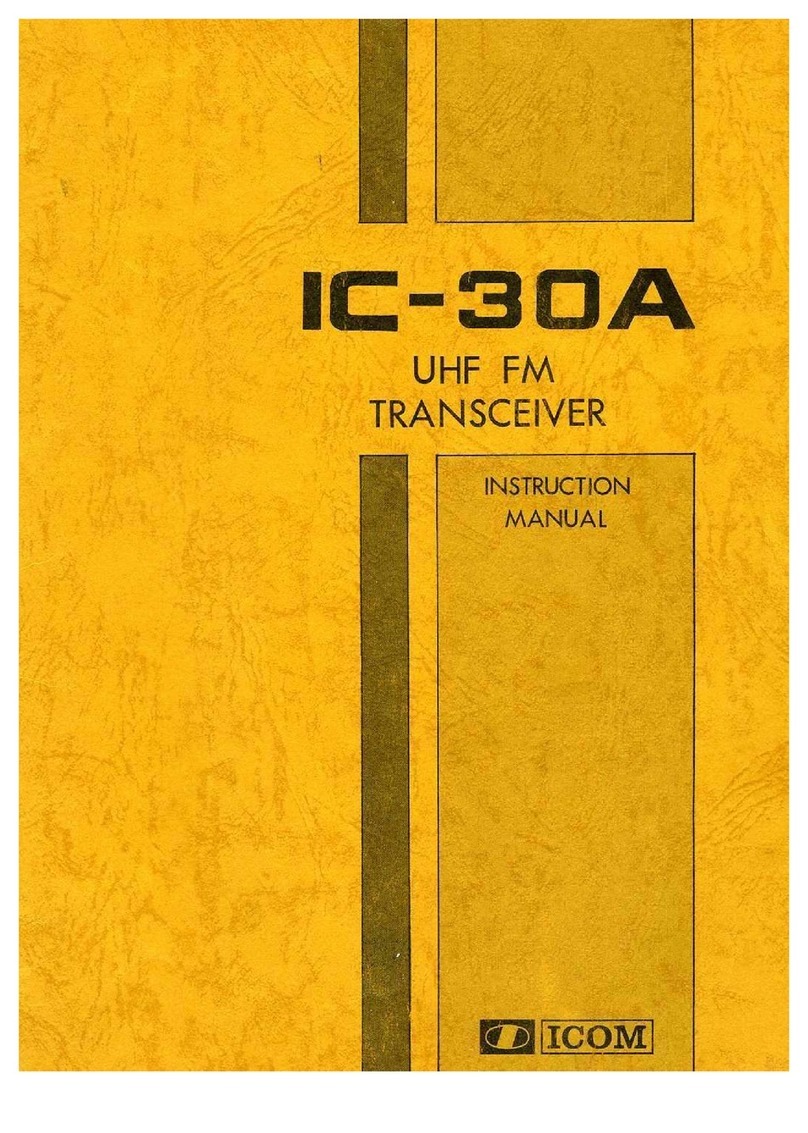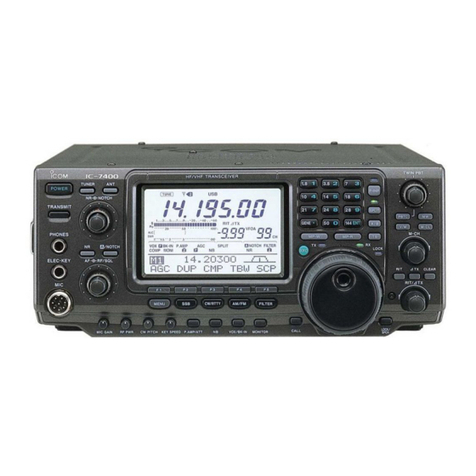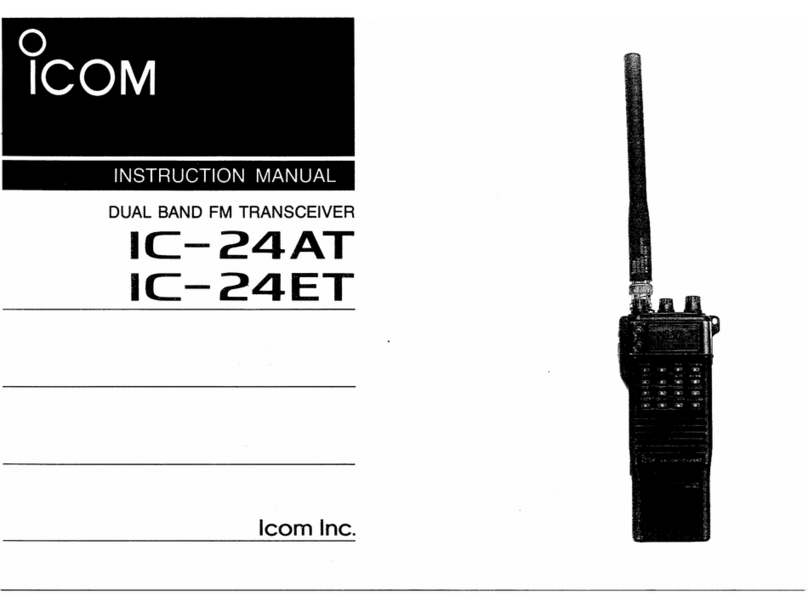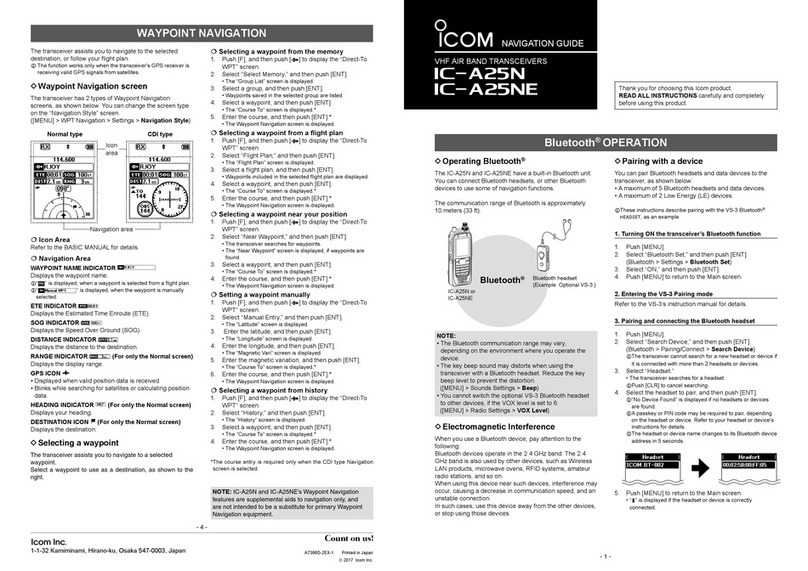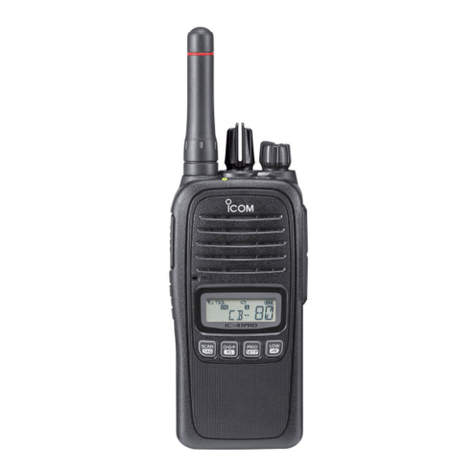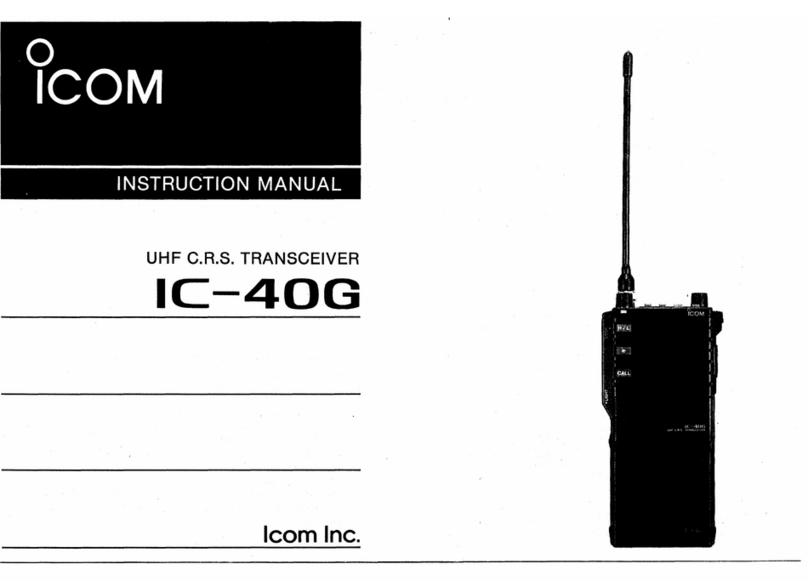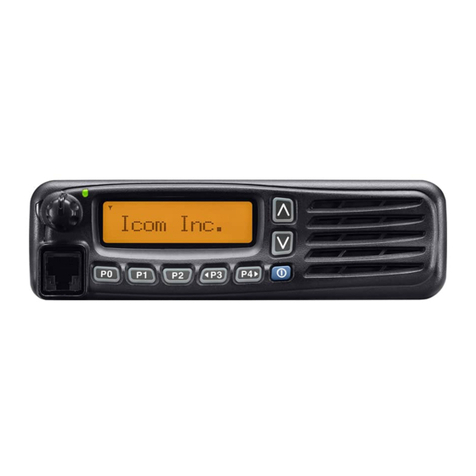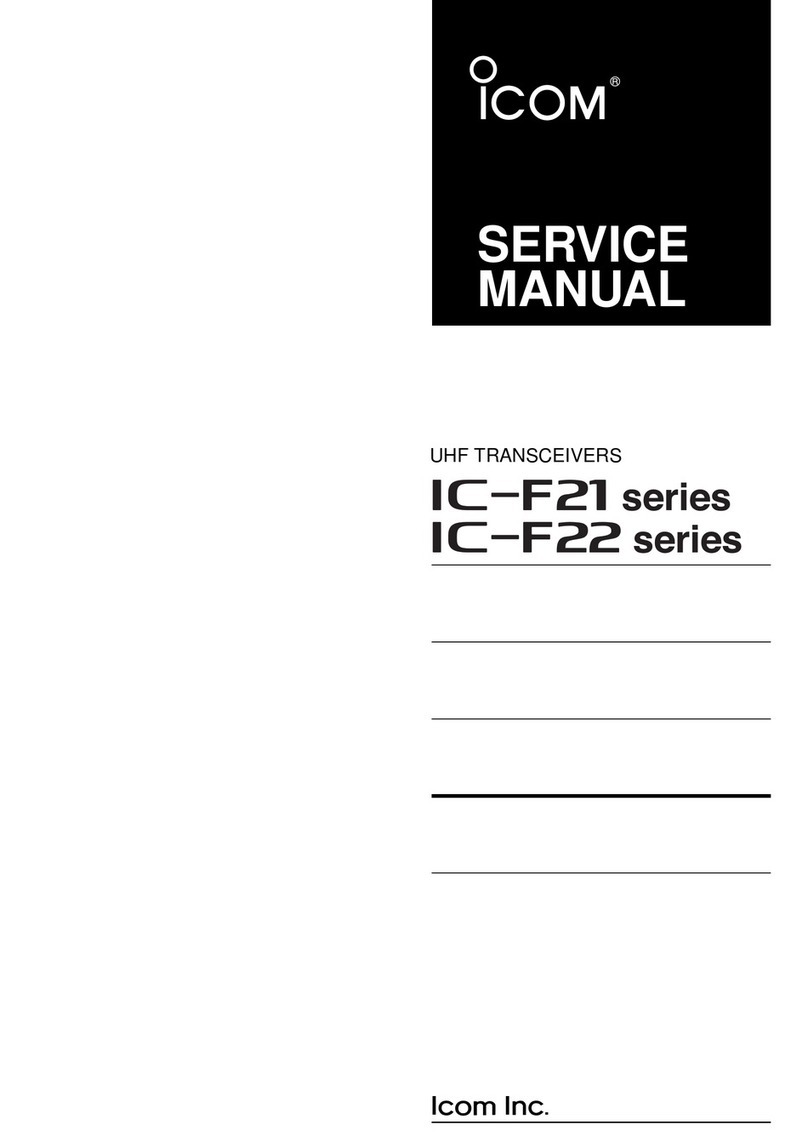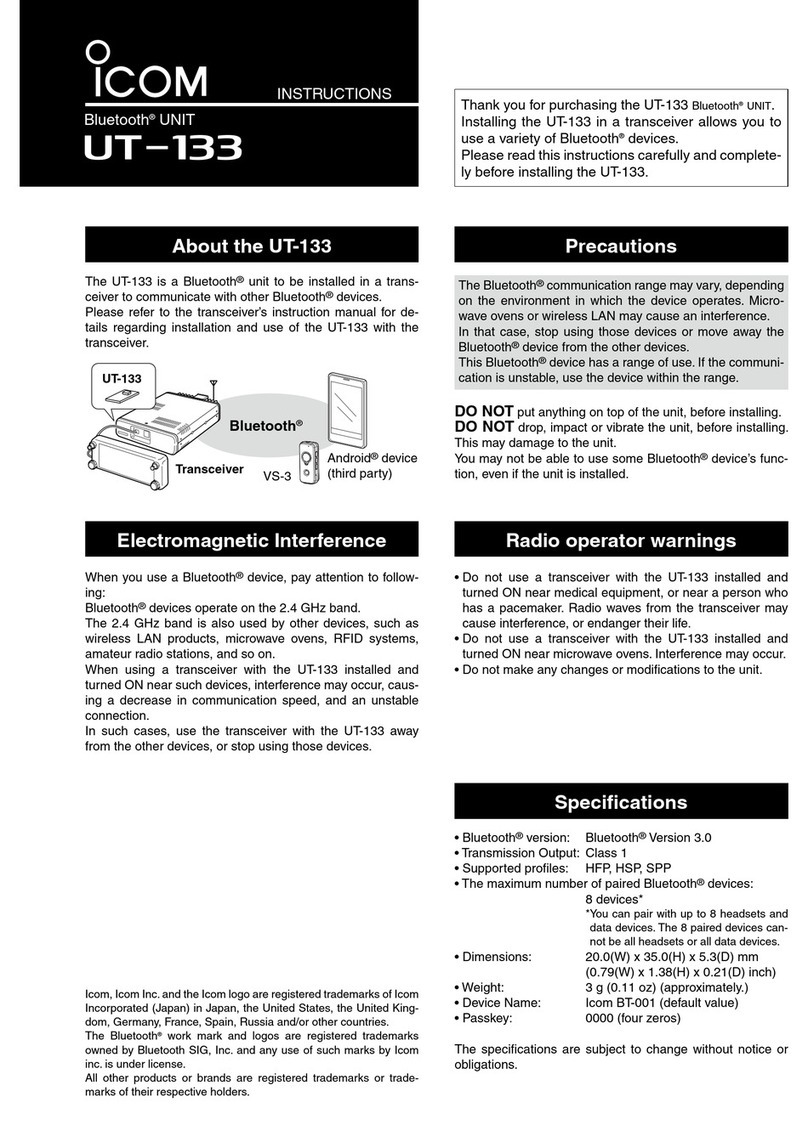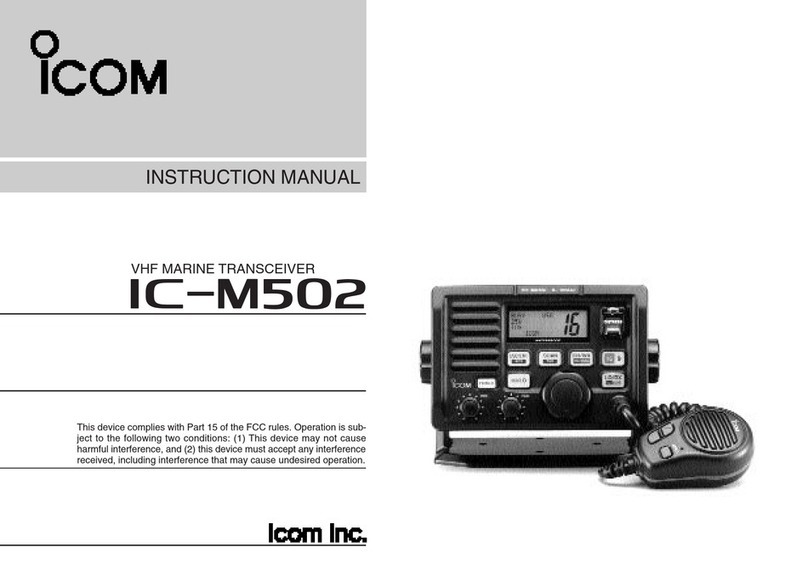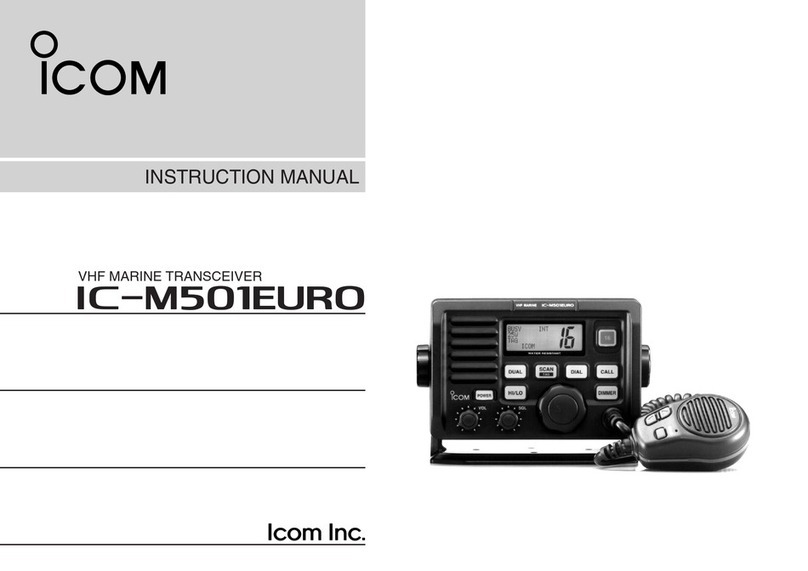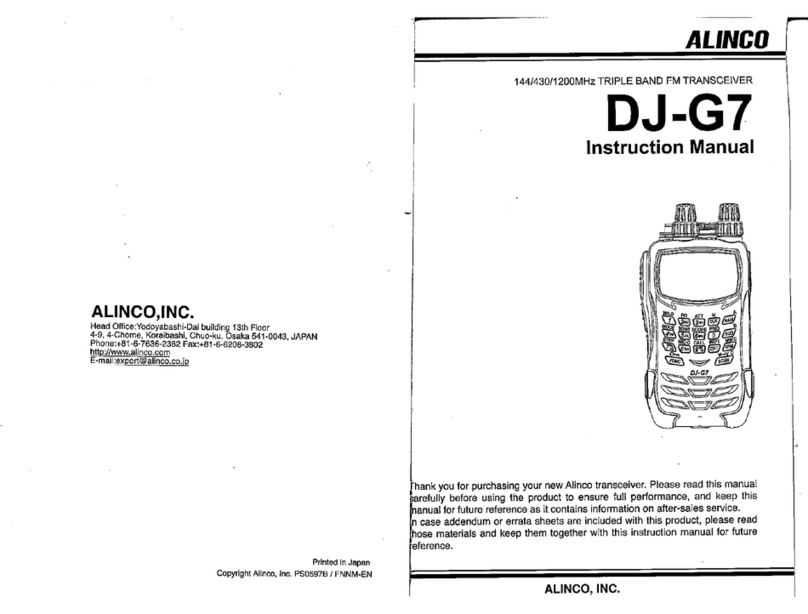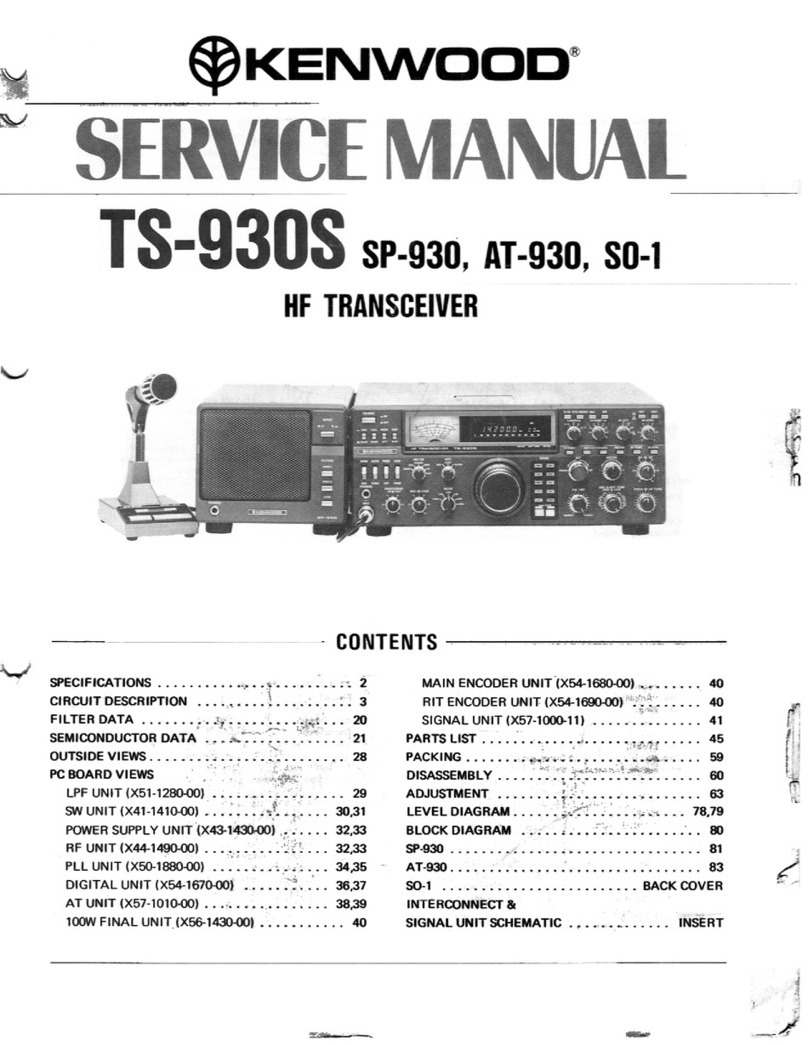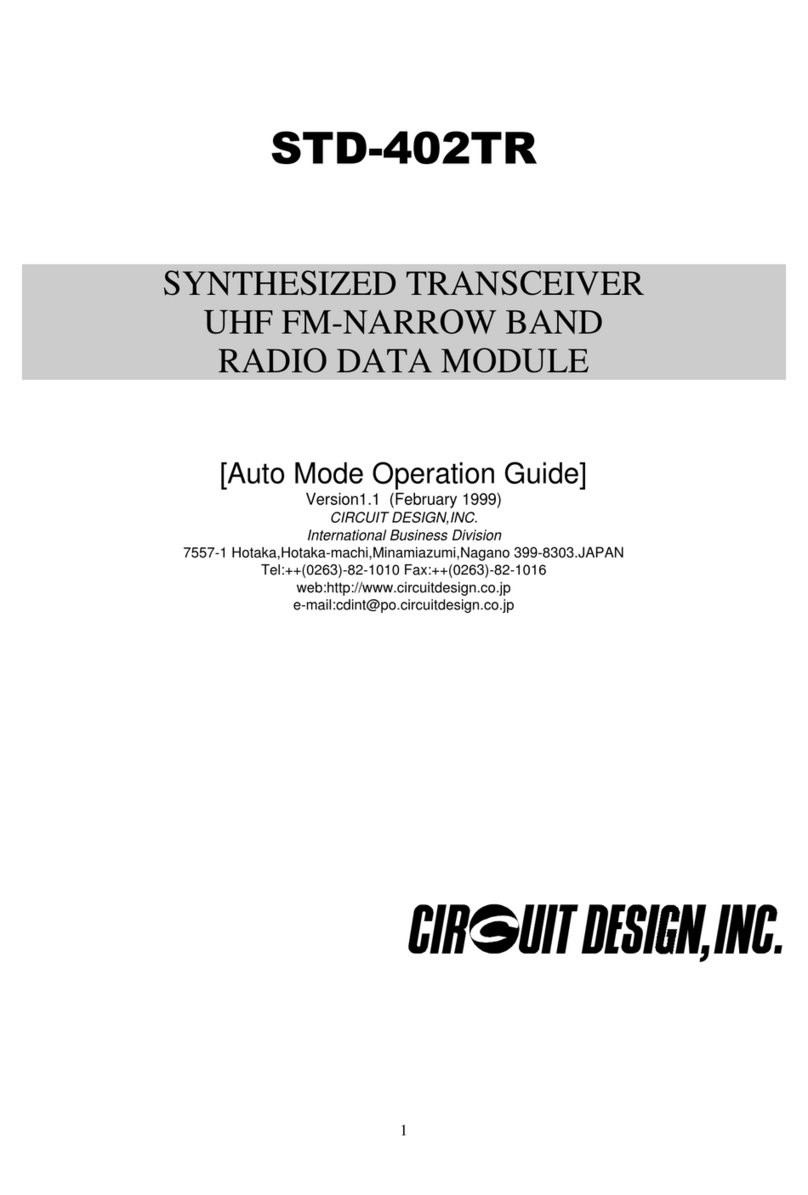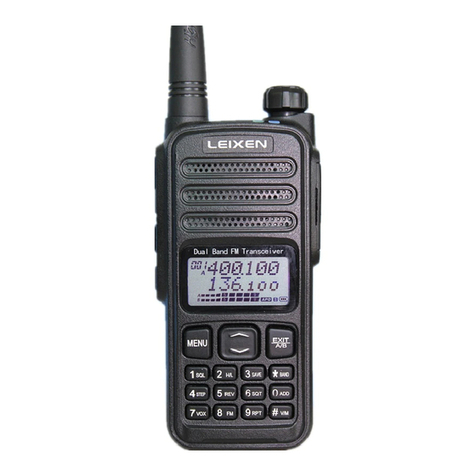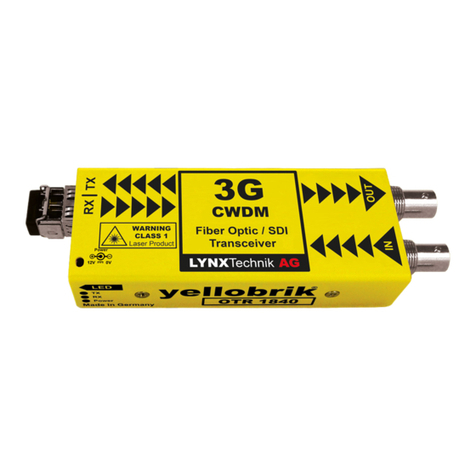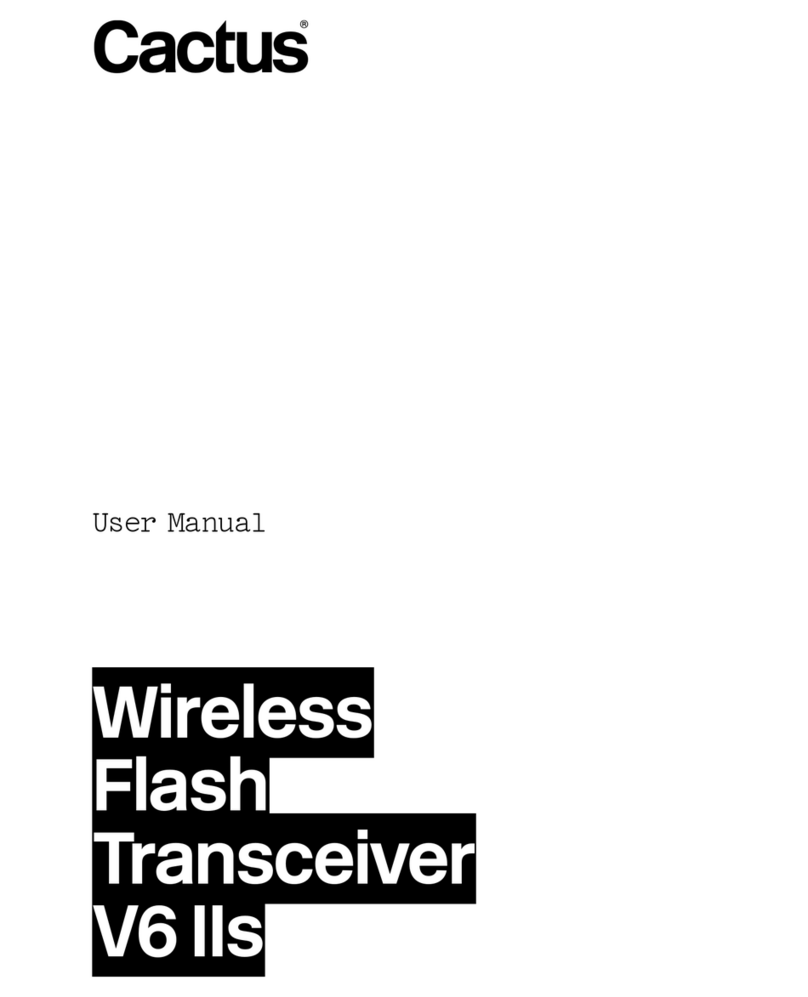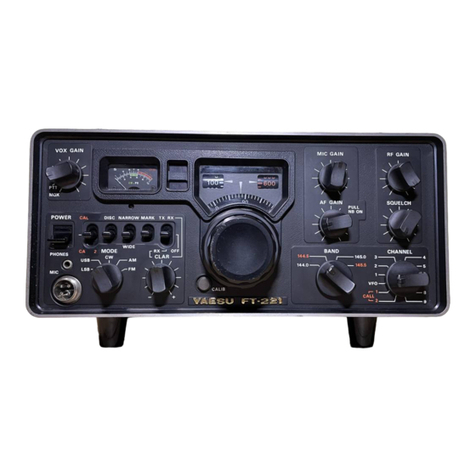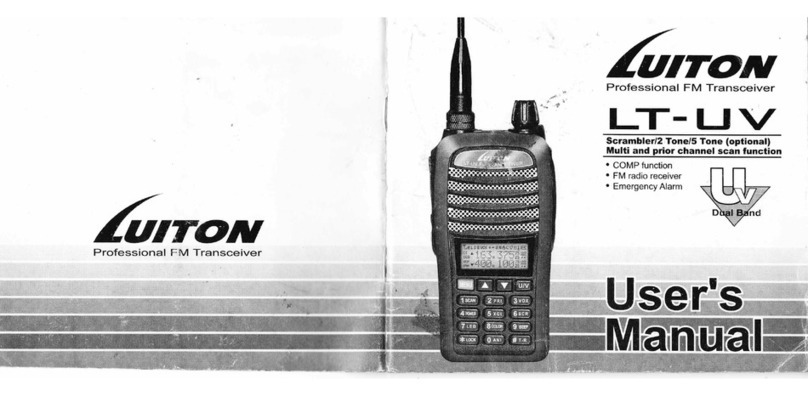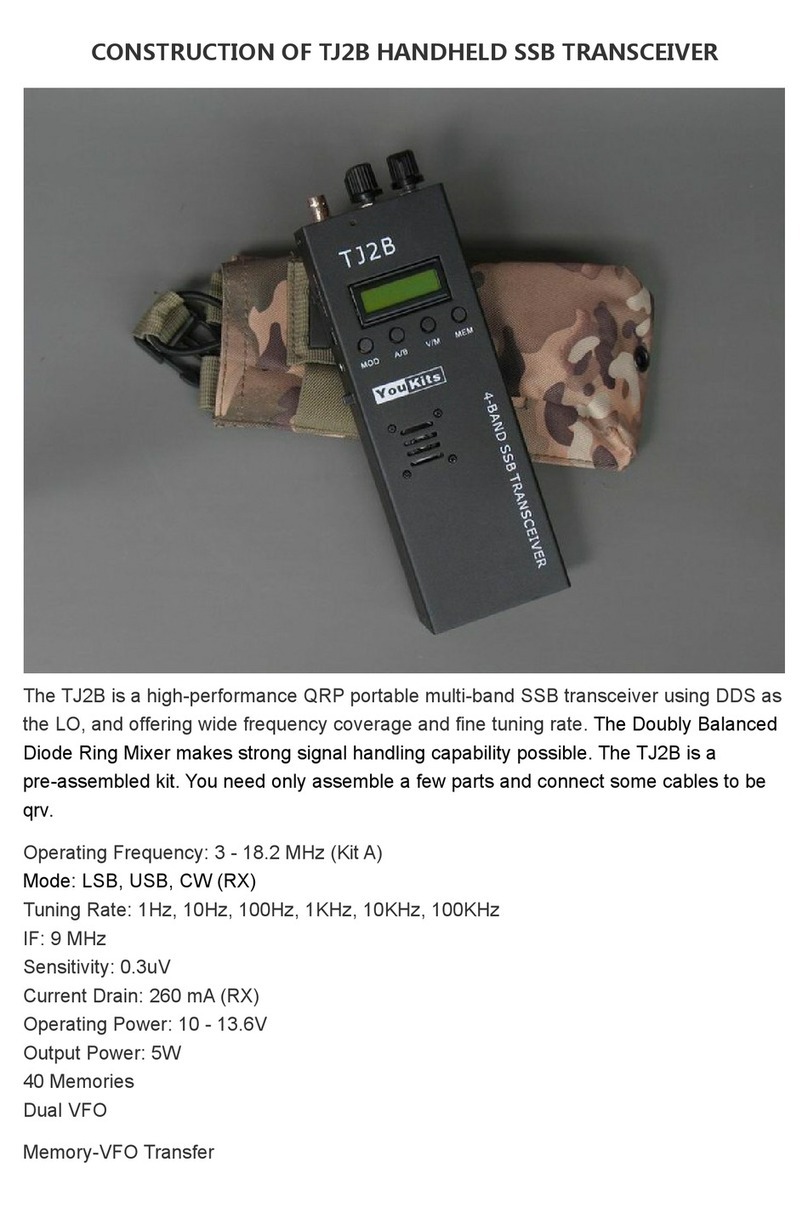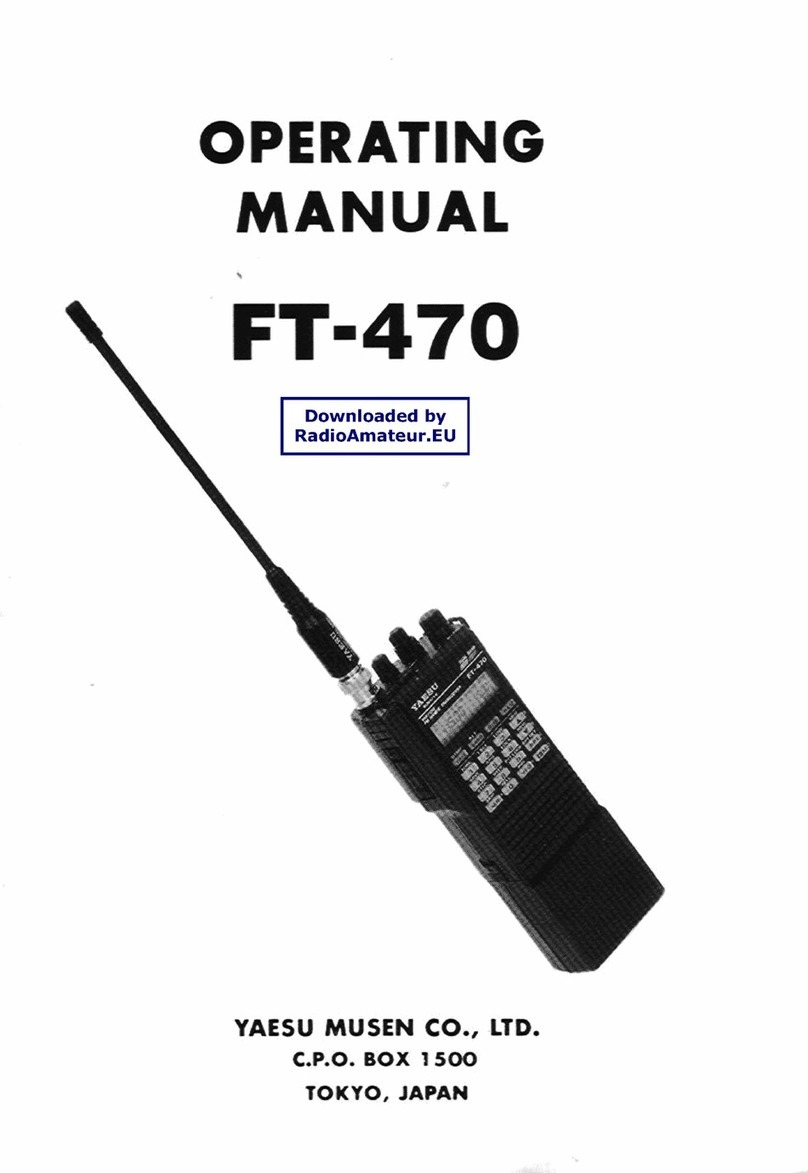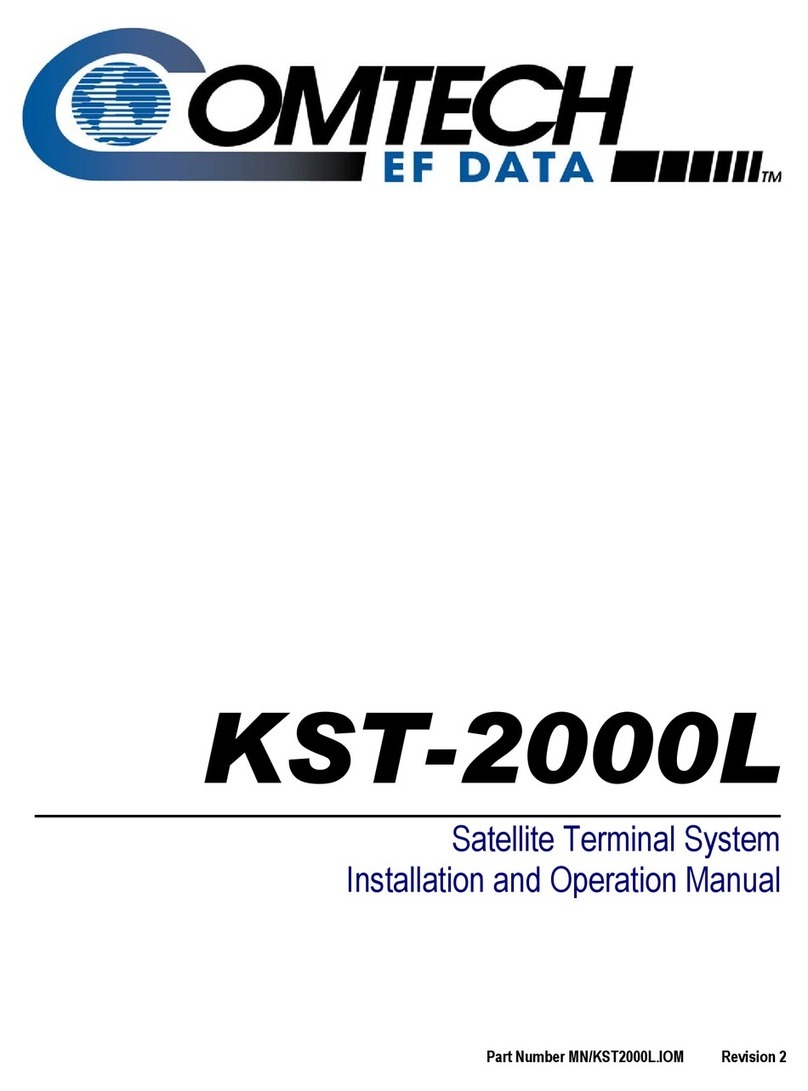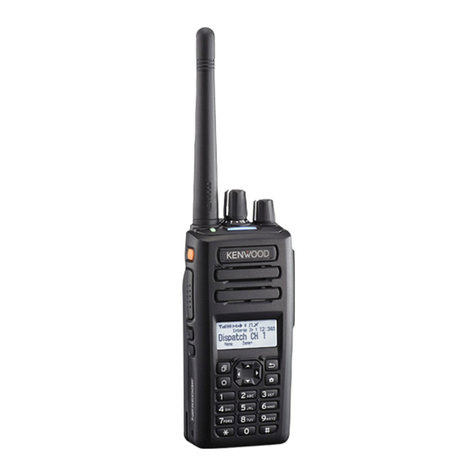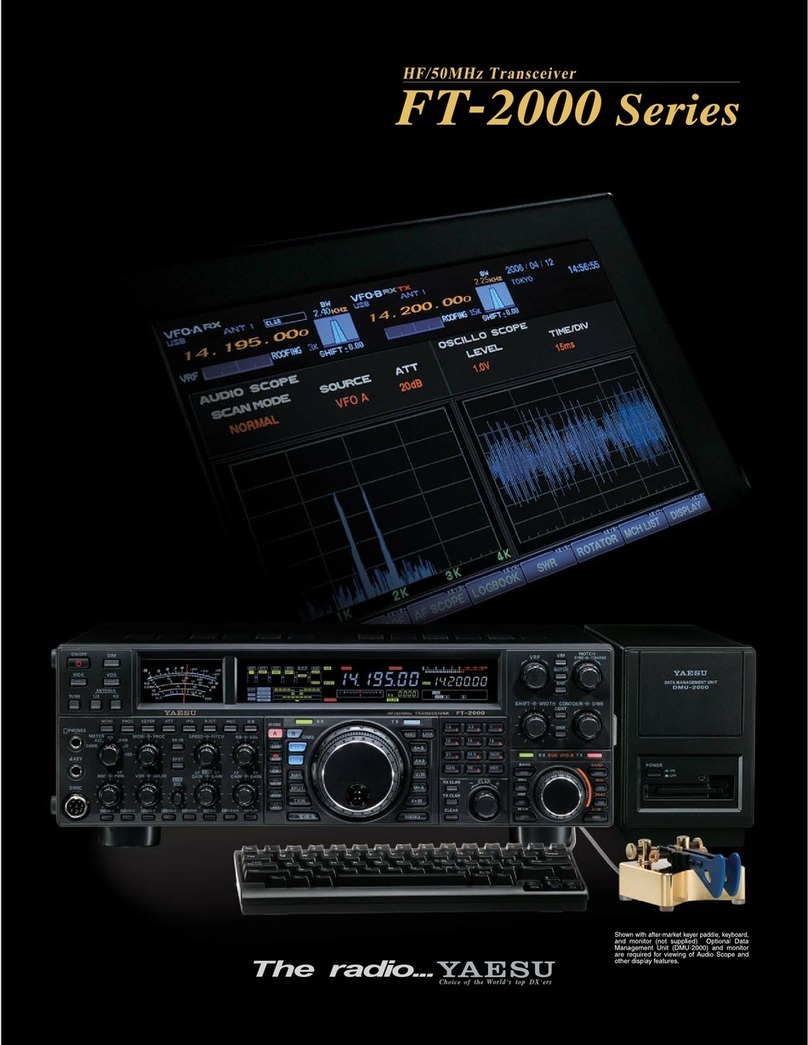Icom IA14 User manual

INSTRUCTION MANUAL
iA14
iA14S
VHF AIR BAND TRANSCEIVER
This device complies with Part 15 of the FCC
Rules. Operation is subject to the condition
that this device does not cause harmful inter-
ference.
YIC-A14 YIC-A14S

i
SAFETY TRAINING INFORMATION
W AR N IN G
Your Icom radio generates RF electromagnetic energy dur-
ing transmit mode. This radio is designed for and classified
as “Occupational Use Only”, meaning it must be used only
during the course of employment by individuals aware of the
hazards, and the ways to minimize such hazards. This radio
is NOT intended for use by the “General Population” in an
uncontrolled environment.
This radio has been evaluated for compliance at the distance of 2.5 cm with
the FCC RF exposure limits for “Occupational Use Only”. In addition, your
Icom radio complies with the following Standards and Guidelines with regard
to RF energy and electromagnetic energy levels and evaluation of such levels
for exposure to humans:
• FCC OET Bulletin 65 Edition 97-01 Supplement C, Evaluating Com-
pliance with FCC Guidelines for Human Exposure to Radio Frequency
Electromagnetic Fields.
• American National Standards Institute (C95.1-1992), IEEE Standard
for Safety Levels with Respect to Human Exposure to Radio Frequency
Electromagnetic Fields, 3 kHz to 300 GHz.
• American National Standards Institute (C95.3-1992), IEEE Recom-
mended Practice for the Measurement of Potentially Hazardous Electro-
magnetic Fields– RF and Microwave.
• The following accessories are authorized for use with this product. Use
of accessories other than those specified may result in RF exposure lev-
els exceeding the FCC requirements for wireless RF exposure.; Belt
Clip (MB-94/96F) and Rechargeable Li-ion Battery Pack (BP-230N/
232N).
To ensure that your expose to RF electromagnetic en-
ergy is within the FCC allowable limits for occupational
use, always adhere to the following guidelines:
•
DO NOT operate the radio without a proper antenna attached, as this
may damage the radio and may also cause you to exceed FCC RF ex-
posure limits. A proper antenna is the antenna supplied with this radio
by the manufacturer or antenna specifically authorized by the manufac-
turer for use with this radio.
•
DO NOT transmit for more than 50% of total radio use time (“50% duty
cycle”). Transmitting more than 50% of the time can cause FCC RF ex-
posure compliance requirements to be exceeded. The radio is transmit-
ting when “ ” appears on the function display. You can cause the
radio to transmit by pressing the “PTT” switch.
•
ALWAYS keep the antenna at least 2.5 cm (1 inch) away from the body
when transmitting and only use the Icom belt-clips which are listed on
page 36 when attaching the radio to your belt, etc., to ensure FCC RF
exposure compliance requirements are not exceeded. To provide the re-
cipients of your transmission the best sound quality, hold the antenna at
least 5 cm (2 inches) from your mouth, and slightly off to one side.
The information listed above provides the user with the information needed
to make him or her aware of RF exposure, and what to do to assure that this
radio operates with the FCC RF exposure limits of this radio.
Electromagnetic Interference/Compatibility
During transmissions, your Icom radio generates RF energy that can possibly
cause interference with other devices or systems. To avoid such interference,
turn off the radio in areas where signs are posted to do so. DO NOT operate
the transmitter in areas that are sensitive to electromagnetic radiation such as
hospitals and blasting sites.
Occupational/Controlled Use
The radio transmitter is used in situations in which persons are exposed as
consequence of their employment provided those persons are fully aware of
the potential for exposure and can exercise control over their exposure.
C AU T IO N

ii
FOREWORD
Thank you for purchasing this Icom product. The IC-A14/S
VHF AIR BAND TRANSCEIVER is designed and built with
Icom’s state of the art technology and craftsmanship. With
proper care this product should provide you with years of
trouble-free operation.
IMPORTANT
READ ALL INSTRUCTIONS carefully and completely
before using the transceiver.
SAVE THIS INSTRUCTION MANUAL—This in-
struction manual contains important operating instructions
for the IC-A14/S.
EXPLICIT DEFINITIONS
SUPPLIED ACCESSORIES
The following accessories are supplied with the transceiver.
Qty.
qFlexible antenna ............................................................. 1
wBattery pack ................................................................... 1
eBelt clip .......................................................................... 1
rHand strap ..................................................................... 1
tBattery charger .............................................................. 1
yAC adapter ..................................................................... 1
WORD DEFINITION
RWARNING
CAUTION
NOTE
Personal injury, fire hazard or electric shock
may occur.
If disregarded, inconvenience only. No risk
of personal injury, fire or electric shock.
Equipment damage may occur.
q w
t y
e
r

RWARNING! NEVER hold the transceiver so that the
antenna is very close to, or touching exposed parts of the
body, especially the face or eyes, while transmitting. The
transceiver will perform best if the microphone is 5 to 10 cm
(231⁄32 to 315⁄16 inch) away from the lips and the transceiver is
vertical.
RWARNING! NEVER operate the transceiver with a
headset or other audio accessories at high volume levels.
Hearing experts advise against continuous high volume op-
eration. If you experience a ringing in your ears, reduce the
volume level or discontinue use.
NEVER short the terminals of the battery pack. Also, cur-
rent may flow into nearby metal objects, such as a necklace,
etc. Therefore, be careful when carrying with, or placing
near metal objects, carrying in handbags, etc.
NEVER use of non-Icom battery packs/chargers to prevent
the loss of the transceiver’s good performance and warranty.
DO NOT allow children to play with any radio equipment
containing a transmitter.
DO NOT operate the transceiver near unshielded electri-
cal blasting caps or in an explosive atmosphere.
DO NOT using or placing the transceiver in direct sunlight
or in areas with temperatures below –10°C (+14°F) or above
+60°C (+140°F).
KEEP the transceiver away from the heavy rain, and
NEVER immerse it in the water. The transceiver construc-
tion is water resistant, not waterproof.
iii
PRECAUTION
Icom, Icom Inc. and the logo are registered trademarks of Icom Incor-
porated (Japan) in the United States, the United Kingdom, Germany, France,
Spain, Russia and/or other countries.
FCC caution: Changes or modifications to this transceiver, not
expressly approved by Icom Inc., could void your authority to
operate this transceiver under FCC regulations. (U.S.A. only)

iv
SAFETY TRAINING INFORMATION ������������ i
FOREWORD����������������������� ii
IMPORTANT����������������������� ii
EXPLICIT DEFINITIONS ����������������� ii
SUPPLIED ACCESSORIES ���������������� ii
PRECAUTION ���������������������� iii
TABLE OF CONTENTS ������������������ iv
1 PANEL DESCRIPTION ��������������� 1–5
nPanel description ������������������ 1
nFunction display������������������� 5
2 ACCESSORY ATTACHMENT ������������ 6–7
3 BASIC OPERATION���������������� 8–11
nSetting a frequency ����������������� 8
nSetting a squelch level ���������������� 9
nLock function �������������������� 9
nReceiving �������������������� 10
nTransmitting ������������������� 10
nSide tone function ����������������� 11
nLCD backlight������������������� 11
nLow battery indicator���������������� 11
4 MEMORY OPERATION �������������� 12–17
nMemory channel selection ������������� 12
nMemory bank selection (Available with the IC-A14 only) 12
nProgramming a memory channel ���������� 13
nMemory names ������������������ 15
nCopying memory contents ������������� 16
n
Clearing the memory contents (Available with the IC-A14 only)
�������������������������� 17
5 SCAN OPERATION ���������������� 18–20
nScan types �������������������� 18
nCOM band scan������������������ 18
nMemory scan ������������������� 19
nWeather channel scan (Available with the IC-A14 only) � 19
n“TAG” channel setting ��������������� 20
6 OTHER FUNCTIONS ��������������� 21–26
nHome function ������������������ 21
nAccessing 121.5 MHz emergency frequency
(Available with the IC-A14 only) ����������� 21
nKey touch beep tone ���������������� 22
nANL function ������������������� 22
nWeather channel operation (Available with the IC-A14 only)
������������������������� 23
nDuplex operation (Available with the IC-A14 only) ��� 24
nSet mode setting ����������������� 25
7 BATTERY PACKS ���������������� 27–31
nBattery charging������������������ 27
nCharging the battery ���������������� 29
8 CLONING �������������������� 32–33
9 TROUBLESHOOTING ���������������� 34
10 SPECIFICATIONS������������������ 35
11 OPTIONS ��������������������� 36
12 OPTIONAL HEADSET CONNECTION ��������� 37
TABLE OF CONTENTS

nPanel description
qANTENNA CONNECTOR [ANT] (p. 6)
Connects the supplied antenna.
wKEY LOCK SWITCH [ ] (p. 9)
Push to turning the key lock function ON.
Push and hold for 2 sec. to turning the key lock func-
tion OFF.
eLIGHT SWITCH [LIGHT]
Push to toggles the LCD backlight ON and OFF. (p. 11)
For IC-A14S only
During memory mode, push and hold for 2 sec. to turn
the “TAG” setting ON and OFF. (p. 20)
rPTT SWITCH [PTT]
Push and hold to transmit; release to receive.
tSQUELCH UP/DOWN KEYS [SQLY]/ [SQLZ](p. 9)
Push either key to select the squelch level.
• 10 squelch levels, 1–10, and squelch open, 0, are available.
yUP/DOWN KEYS [Y]/[Z]
Push to change or select the operating frequency,
memory channel, set mode setting, etc. (p. 8)
While scanning, push to change the scanning direc-
tion. (pgs. 18, 19)
For IC-A14S only
Push and hold for 1 sec. to start scanning. (pgs. 18, 19)
1
1PANEL DESCRIPTION
q
w
r
e!0
Function
display (p. 5)
o
i
u
Microphone
Speaker
!1
t
y

2
uKEYPAD (Available with the IC-A14 only; pgs. 3, 4)
iMEMORY MODE/MEMORY WRITE KEY [MR]/[MW]
Push to select memory mode. (p. 12)
For IC-A14
Push [FUNC] then push this key enters select memory
write mode. (p. 13)
During memory mode, push [FUNC] then push this
key to copy the memory content into frequency mode.
(p. 16)
For IC-A14S
Push and hold for 1 sec. to enter select memory write
mode. (p. 14)
During memory mode, push and hold for 1 sec. to
copy the memory content into frequency mode. (p. 16)
oCLEAR/HOME SWITCH [CLR]/[HOME]
Push to select frequency mode. (p. 8)
Push and hold for 2 sec. to resetting the transceiver
into the user-default condition without memory con-
tents (home function). (p. 21)
!0 EXTERNAL SPEAKER AND MICROPHONE JACKS
[MIC/SP] (p. 37)
Connects the optional speaker microphone or a headset
using with the optional OPC-499 HEADSET ADAPTER, if
desired.
NEVER connect an optional speaker-microphone,
headset adapter, etc. while the transceiver power is
ON.
!1 VOLUME CONTROL KNOB [VOL]
Rotate to turn the transceiver power ON/OFF and adjusts
the audio level.
1
PANEL DESCRIPTION
Jack cover
NOTE: Attach the jack
cover when the optional
equipment is not used.
1
2
3
4
5
6
7
8
9
10
11
12
13
14
15
16
17
18
19

3
1PANEL DESCRIPTION
DKEYPAD (Available with IC-A14 only)
Inputs digit “1” for frequency input or memory
channel selection, etc. (pgs. 8, 12)
Inputs “1,” “Q,” or “Z” during memory name pro-
gramming.
(p. 15)
After pushing [FUNC], turns the ANL (Automatic
Noise Limiter) function ON and OFF. (p. 22)
Inputs digit “2” for frequency input or memory
channel selection, etc. (pgs. 8, 12)
Inputs “2,” “A,” “B,” or “C” during memory name
programming.
(p. 15)
After pushing [FUNC], starts the scan. (pgs. 18,
19)
Inputs digit “3” for frequency input or memory
channel selection, etc. (pgs. 8, 12)
Inputs “3,” “D,” “E,” or “F” during memory name
programming.
(p. 15)
After pushing [FUNC], selects memory bank
mode, during memory mode. (p. 12)
Inputs digit “4” for frequency input or memory
channel selection, etc. (pgs. 8, 12)
Inputs “4,” “G,” “H,” or “I” during memory name
programming.
(p. 15)
After pushing [FUNC], turns the weather alert
function ON and OFF. (p. 23)
Inputs digit “5” for frequency input or memory
channel selection, etc. (pgs. 8, 12)
Inputs “5,” “J,” “K,” or “L” during memory name
programming.
(p. 15)
After pushing [FUNC], enters duplex transmit
frequency programming condition, during NAVI
band operation. (p. 24)
Inputs digit “6” for frequency input or memory
channel selection, etc. (pgs. 8, 12)
Inputs “6,” “M,” “N,” or “O” during memory name
programming.
(p. 15)
After pushing [FUNC], selects duplex operation
during NAVI band operation. (p. 24)
Inputs digit “7” for frequency input or memory
channel selection, etc. (pgs. 8, 12)
Inputs “7,” “P,” “R,” or “S” during memory name
programming.
(p. 15)
After pushing [FUNC], selects weather channel
mode. (p. 23)
Inputs digit “8” for frequency input or memory
channel selection, etc. (pgs. 8, 12)
Inputs “8,” “T,” “U,” or “V” during memory name
programming.
(p. 15)
After pushing [FUNC], key touch beep output ON
and OFF. (p. 22)

4
1
PANEL DESCRIPTION
Inputs digit “9” for frequency input or memory
channel selection, etc. (pgs. 8, 12)
Inputs “9,” “W,” “X,” or “Y” during memory name
programming.
(p. 15)
After pushing [FUNC], toggles scan tag setting
ON and OFF. (p. 20)
Inputs digit “0” for frequency input or memory
channel selection, etc. (pgs. 8, 12)
Inputs “0,” “space” or “–” during memory name
programming. (p. 15)
After pushing [FUNC], selects the emergency
frequency, 121.500 MHz. (p. 21)
Completes the numeral input for frequency or
memory channel number, etc. Enters consecu-
tive zero into the following digits.
(pgs. 8, 12)
After pushing [FUNC], push and hold for 1 sec.
to entering into set mode.
(p. 25)
Push to call up the function indicator, “F”, then
push another key to access its secondary func-
tion.
1
2
3
4
5
6
7
8
9
10
11
12
13
14
15
16
17
18
19

5
1PANEL DESCRIPTION
nFunction display
qFUNCTION INDICATOR
Appears when [FUNC] is pushed.
wMEMORY INDICATOR (p. 12)
Appears when memory channel mode is selected.
eTAG INDICATOR (p. 20)
Appears when the selected memory channel is set as a
TAG channel.
rRX INDICATOR (p. 10)
Appears when receiving a signal or when the squelch
opens.
tTX INDICATOR (p. 10)
Appears while transmitting.
yDUPLEX INDICATOR (IC-A14 only) (p. 24)
Appears when the duplex function is activate.
Blinks while setting the duplex frequency.
uANL INDICATOR (p. 22)
Appears when the ANL (Automatic Noise Limiter) func-
tion is in use.
iWEATHER ALERT INDICATOR (IC-A14 only) (p. 23)
Appears when the weather alert function is in use.
oLOCK INDICATOR (p. 9)
Appears when the lock function is in use.
!0 LOW BATTERY INDICATOR (p. 11)
Appears when the battery is nearing exhaustion. The
attached battery pack requires recharging when this
indicator ON.
Blinks when battery replacement is necessary.
!1 FREQUENCY READOUT
Shows the operating frequency, memory channel
number, memory name, set mode item, etc., depending
on the selected condition.
q w e r t y u i o
!1
!0

6
2
ACCESSORY ATTACHMENT
DAntenna
Insert the supplied antenna into the
antenna connector and screw down
the antenna as shown at right.
CAUTION!
•
NEVER carry the transceiver by
the antenna.
•
DO NOT transmit without an
antenna. Otherwise the transceiv-
er may be damaged.
DBelt clip
Conveniently attaches to your belt.
Attach the belt clip as described below.
qRelease the battery pack if it is attached.
wSlide the belt clip in the direction of the arrow until the belt
clip is locked and makes a ‘click’ sound.
- When detaching the belt clip
qRelease the battery pack if it is attached.
wPinch the clip (q), and slide the belt clip in the direction
of the arrow (w).
q
w
1
2
3
4
5
6
7
8
9
10
11
12
13
14
15
16
17
18
19

7
DBattery pack attachment
Slide the battery pack in the direction of the arrow (q), then
lock it with the battery release button.
• Slide the battery pack until the battery release button makes a
‘click’ sound.
To release the battery pack:
Slide the battery release button in the direction of the arrow
(w) as shown in the illustration at right. The battery pack is
then released.
NEVER release or attach the battery pack when the
transceiver is wet or soiled. This may result water or dust
getting into the transceiver/battery pack and may result in
the transceiver being damaged.
2ACCESSORY ATTACHMENT
q
w
Battery release button
Turn the transceiver power OFF with [VOL] before attach-
ing or detaching the battery pack.
For your information
If the transceiver power cannot be turned ON when replac-
ing with the fully charged battery pack, perform as follow.
Detach the battery pack and wait for a while (approx.
10 sec.), then attach the battery pack then turn power ON.

8
3
BASIC OPERATION
nSetting a frequency
DUsing [Y]/[Z] keys
qRotate [VOL] to turn power ON, then push [CLR] to se-
lect the frequency mode when memory CH number or
WX CH number appears on the function display.
wPush [Y]/[Z]to set the desired frequency.
- For IC-A14 only -
• 1 MHz tuning step is available with the IC-A14; push
[FUNC], then push [Y]/[Z]. Push [FUNC] again to re-
turn the normal tuning.
DUsing keypad (IC-A14 only)
qRotate [VOL] to turn power ON, then push [CLR] to se-
lect the frequency mode when memory CH number or
WX CH number appears on the function display.
wPush 5 appropriate digit keys to input the frequency.
• Push [1] as the 1st digit.
• When a wrong digit is input, push [CLR] to clear, then repeat
step wagain.
• Push [ENT] to enter consecutive zero digits.
• Only [2], [5], [7] and [0] can be entered as the 5th and final
digit.
[EXAMPLE]
• 111.225 MHz: Push [1], [1], [1], [2], [2]
• 117.250 MHz: Push [1], [1], [7], [2], [5]
• 120.000 MHz: Push [1], [2], [ENT]
• 125.300 MHz: Push [1], [2], [5], [3], [ENT]
2
3
[VOL]
[FUNC]
[Z]
[ENT]
[CLR]
[Y]
Keypad
1
4
5
6
7
8
9
10
11
12
13
14
15
16
17
18
19

nSetting a squelch level
The transceiver has a noise squelch circuit to mute unde-
sired noise while receiving no signal.
qPush [SQLY]or [SQLZ]to select the squelch level.
• ‘SQL--0’ is open squelch and ‘SQL--10’ is tight squelch.
• “ ” indicator appears while the squelch is open.
w
Wait for 1 sec. to return to the previous indication.
nLock function
The lock function prevents accidental frequency changes
and accidental function activation.
qPush [ ] to turn the lock function ON.
• “ ” indicator appears.
wTo turn the function OFF, push and hold [ ] for 2 sec.
• “ ” indicator disappears.
9
3BASIC OPERATION
[SQLY]
“SQL-- 0”; Squelch open
[SQLZ]
[]
Appears while key lock
function is activated.

10
3
BASIC OPERATION
3
nReceiving
q Rotate [VOL] to turn the power ON.
wPush [SQLZ]several times to open the squelch.
• Select the squelch level 0.
e Rotate [VOL] to adjust the audio level.
r
Push [SQLY]several times until the noise is muted.
• “ ” indicator disappears.
t Set the desired frequency using [Y]/[Z]keys or keypad.
y When a signal is received on the set frequency:
• “ ” indicator appears.
• Squelch opens and audio is emitted from the speaker.
When squelch setting is too “tight” (large number setting),
squelch may not open for weak signals. To receive weaker
signals, loosen (small number setting) the squelch.
nTransmitting
q Set the desired frequency in COM band using [Y]/[Z]or
keypad (IC-A14 only).
• COM band frequency range: 118.00–136.975 MHz
w Push and hold [PTT] to transmit.
• “ ” indicator appears.
e Speak into the microphone at a normal voice level.
• DO NOT hold the transceiver too close to your mouth or speak
too loudly. This may distort the signal.
r Release [PTT] to return to receive.
NOTE: About Time-Out-Timer function
For the prevention of prolonged transmission, etc., ac-
cording to regulatory requirements, the IC-A14/S has a
Time-Out-Timer function. This timer cuts a transmission
OFF after the set time period of continuous transmission.
The time-out timer is specified in set mode. See page 26
for details.
CAUTION: Transmitting without an antenna may damage
the transceiver.
NOTE: To prevent interference, listen on the frequency
before transmitting. If the frequency is busy, wait until the
channel is clear.
[PTT]
Microphone
Appears while transmitting
Appears when receiving a signal.
1
2
4
5
6
7
8
9
10
11
12
13
14
15
16
17
18
19

11
3BASIC OPERATION
nSide tone function
When using a headset (other manufacture’s products),the
transceiver outputs your transmitted voice to the headset
for monitoring. Connect the optional headset with the trans-
ceiver when using this function (OPC-499 HEADSET ADAPTER
and headset are required). (p. 37)
DSetting the side tone level
qPush [PTT] to turn the transmit mode ON.
wDuring transmit, push [Y]/[Z]to adjust the level.
• ‘ST--0’ is OFF and ‘ST--10’ is maximum level.
WARNING! NEVER operate the transceiver with a head-
set at high volume/monitor levels for long period. A ring-
ing in your ears may occur. If so, reduce the volume
/monitor level or discontinue use.
nLCD backlight
The IC-A14/S has LCD backlight for convenience during
night time operation.
Push [LIGHT] to turn the LCD
backlight ON and OFF.
IMPORTANT!
Light OFF the LCD back-
light when no backlight is
necessary.
nLow battery indicator
Low battery indicator appears or blinks when the battery
power has decreased to a specified level. The attached bat-
tery pack requires recharging.
If no battery charging is performed even the low battery in-
dicator blinks, emits a long beep then the transceiver power
turned OFF automatically.
[PTT]
[Z]/[Y]
Side tone level is indicated
IMPORTANT!
Select ‘ST--0’ when a speaker
microphone is connected, oth-
erwise your voice will be heard
from the speaker during trans-
mit.
[LIGHT]
Appears when the battery
is nearly exhausted.
Blinks when the battery
replacement is necessary.

12
4
MEMORY OPERATION
nMemory channel selection
IC-A14 has 200 memory channels (20 channels × 10 banks; de-
fault setting) and IC-A14S has 100 memory channels for stor-
age of often-used frequencies.
q Push [MR] to select memory mode.
• Memory indicator appears and memory channel number is dis-
played briefly.
• Memory bank number also displays with IC-A14.
Using [Y]/[Z]:
w Push [Y]/[Z]to select the desired memory CH number.
• Memory channel number is displayed briefly, then programmed
frequency (or memory name, if programmed) is displayed.
• If no memory CH is programmed, no memory CH selection is
available.
Using the Keypad— IC-A14 only:
w Push 2 appropriate digit key (00 to 99, depending on
bank setting condition) to select the desired memory CH
number, then push [ENT].
• Memory channel number is displayed briefly, then programmed
frequency (or memory name, if programmed) is displayed.
• If no memory CH is programmed in the selected BANK, no
memory CH selection is available.
nMemory bank selection
(Available with the IC-A14 only)
A 200 of the IC-A14’s memory channels are divided into
bank (up to 10 banks are available depending on setting) for sim-
ple memory grouping.
q Push [MR] to select memory mode.
w Push [FUNC], and push [BANK](3) to enter bank selec-
tion mode.
ePush [Y]/[Z]or ap-
propriate digit key
([0] to [9]) to enter
the desired memory
BANK number, then
push [ENT].
rPush [Y]/[Z], or 2
appropriate digit key
and [ENT] to select
the desired memory
channel.
Appears when memory
mode is selected.
Appears when bank selec-
tion mode is selected.
Keypad
[FUNC]
[Z]
[ENT]
[BANK](3)
[MR]
[Y]
1
2
3
4
5
6
7
8
9
10
11
12
13
14
15
16
17
18
19

nProgramming a memory channel
Program often-used frequencies with the following instruc-
tions.
DFor IC-A14
q Push [CLR] to select the frequency mode, if necessary.
w Set the desired frequency. (p. 8)
• Push [FUNC], then push [WX](7) to select a weather chan-
nel mode, and then select the desired weather channel using
[Y]/[Z]or keypad if desired. (p. 23)
ePush [FUNC] then push [MW](MR) to enter the select
memory write mode.
• Memory mode indicator blinks.
rPush [Y]/[Z]to select the desired memory channel
number.
• Push [FUNC], then push [BANK](3) to enter bank selection
mode, and push [Y]/[Z]or appropriate digit key ([0]–[9]), then
push [ENT] to select the BANK number if desired.
tPush [ENT] to program the set condition into the memory
channel and return to the frequency mode.
13
4MEMORY OPERATION
• EXAMPLE: Programming WX-05 into memory channel 9
in memory BANK 3.
Blinks when select memory
write mode is selected.
No frequency is displayed when a blank channel is
selected.
Push
Push then
Push then
Push then
Push or ,
or, push
Push or ,
or, push
Push then
*Shows briefly.
Push to complete the programmig.
*Shows briefly.

14
4
MEMORY OPERATION
DFor IC-A14S
q Push [CLR] to select the frequency mode, if necessary.
w Set the desired frequency. (p. 8)
ePush and hold [MR] for 1 sec. to enter the select memory
write mode.
• Memory mode indicator blinks.
rPush [Y]/[Z]to select the desired memory channel
number.
tPush and hold [MR] for 1 sec. to program the set condi-
tion into the memory channel and return to the frequency
mode.
Blinks when select memory
write mode is selected.
No frequency is displayed when a blank channel is
selected.
• EXAMPLE: Programming 123.450 MHz into memory
channel 51.
Push or
Push or
*Shows briefly.
Push and hold
for 1 sec.
Push and hold
for 1 sec.
Push
1
2
3
4
5
6
7
8
9
10
11
12
13
14
15
16
17
18
19

15
4MEMORY OPERATION
nMemory names
The memory channel can display an 8-character name in-
stead of the programmed frequency.
DProgramming memory names
q Set the desired frequency in frequency mode. (p. 8)
wEnter the select memory write mode.
• For IC-A14; push [FUNC] then push [MW](MR).
• For IC-A14S; push and hold [MR] for 1 sec.
e Select the desired memory channel to be programmed
with [Y]/[Z](or keypad and [ENT]; for IC-A14 only).
rPush [MR] momentarily to enter the memory name pro-
gramming mode.
• “-- -- -- -- -- -- -- --” appears and 1st digit blinks.
• Available characters
For IC-A14
t Push the appropriate digit key several times to select the
desired character as listed at right.
• To move the cursor forwards or backwards, use [Y]/[Z].
• The cursor moves forwards automatically when a different key
is pushed.
• To erase a character, overwrite with a space (displayed as “_”).
y Push [ENT] to program the name and frequency at the
same time.
• Return to the frequency indication.
• When no name is programmed, the display shows the pro-
grammed frequency.
• To clear the entered memory names, push [CLR] before push-
ing [ENT].
For IC-A14S
t
Push [Y]/[Z]several times to select the desired character.
• To move the cursor forwards, use [MR].
• To erase a character, overwrite with a space (displayed as “_”).
y Push and hold [MR] for 1 sec. to program the name and
frequency at the same time.
• Return to the frequency indication.
• When no name is programmed, the display shows the pro-
grammed frequency.
• To clear the entered memory names, push [CLR] before push-
ing and holding [MR] for 1 sec.
KEY CHARACTER KEY CHARACTER
[1] 1, Q, Z [6] 6, M, N, O,
[2] 2, A, B, C [7] 7, P, R, S
[3] 3, D, E, F [8] 8, T, U, V
[4] 4, G, H, I [9] 9, W, X, Y
[5] 5, J, K, L [0] 0, _ (space), –
This manual suits for next models
1
Table of contents
Other Icom Transceiver manuals

Icom
Icom IC-F3162D series User manual
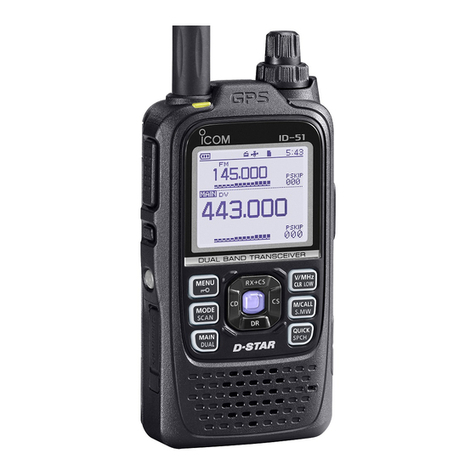
Icom
Icom ID-51A Setup guide
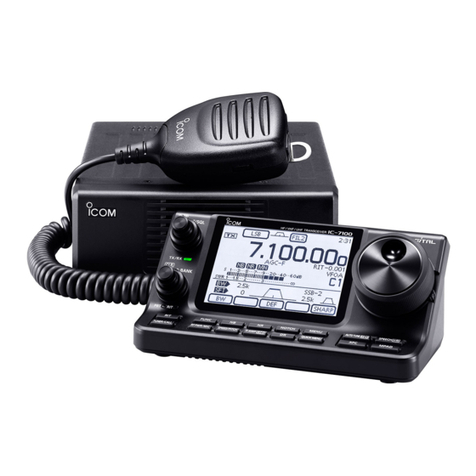
Icom
Icom IC-7100 Installation guide
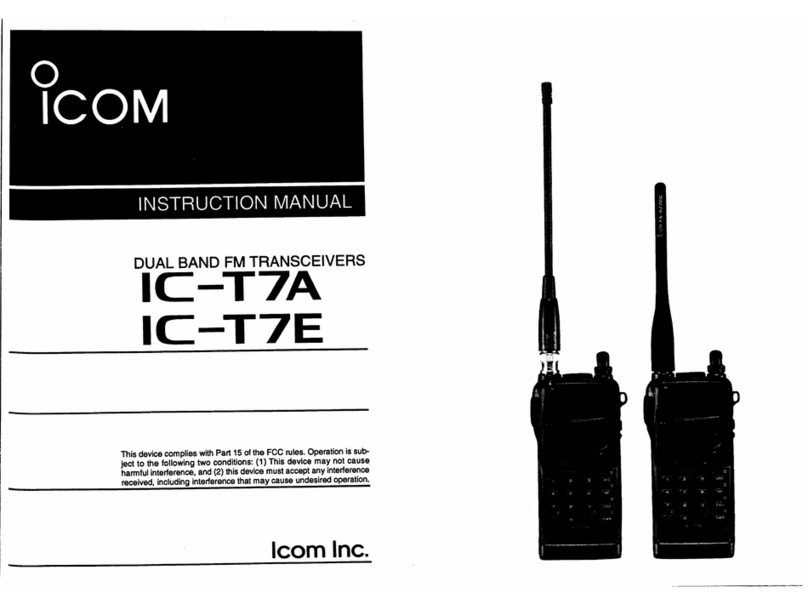
Icom
Icom IC-T7A User manual
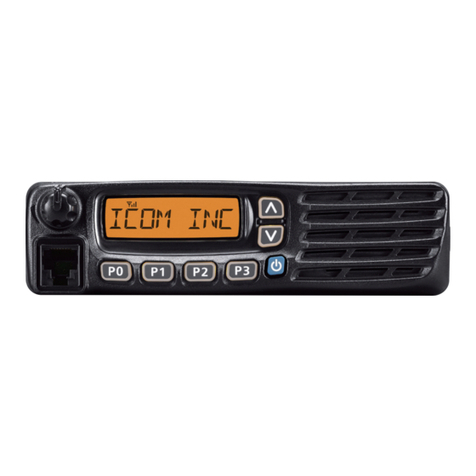
Icom
Icom IC-F6121D-51B User manual
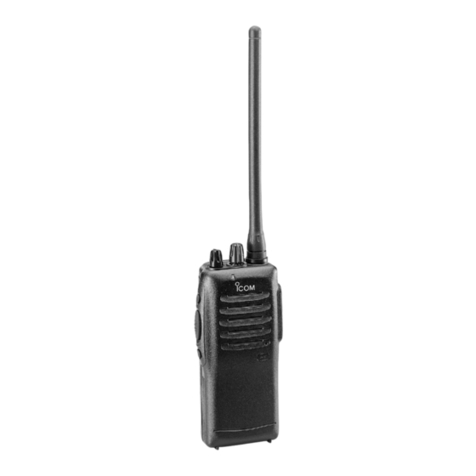
Icom
Icom IC-F11 Guide
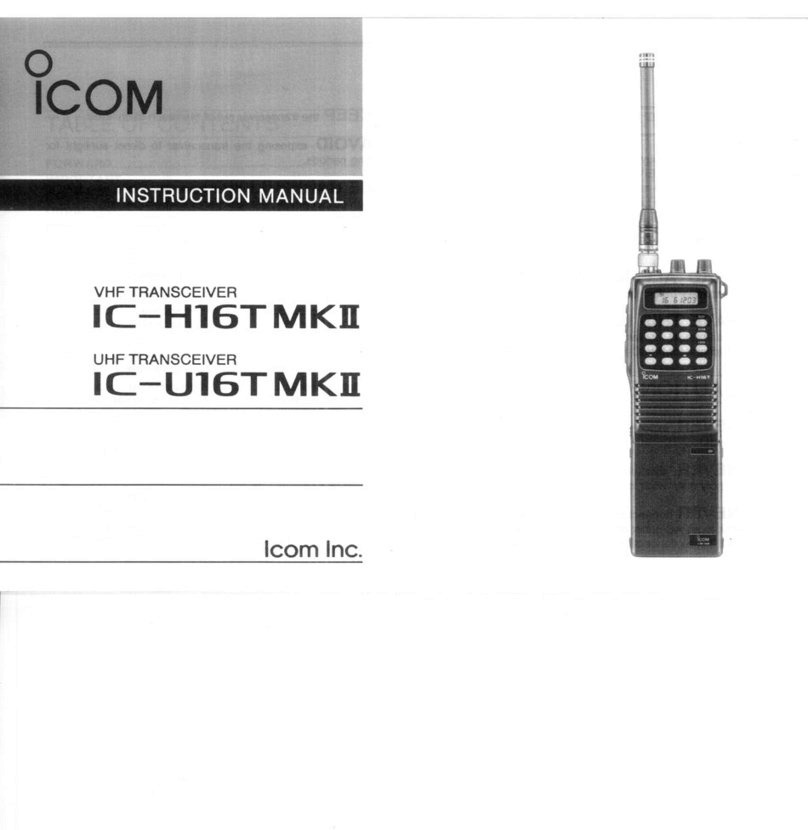
Icom
Icom IC-H16T MKII User manual
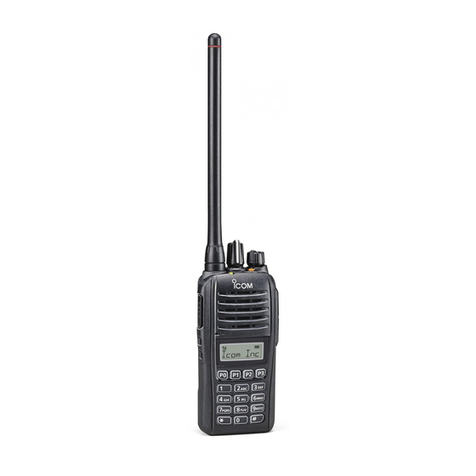
Icom
Icom IC-F1000 series User manual
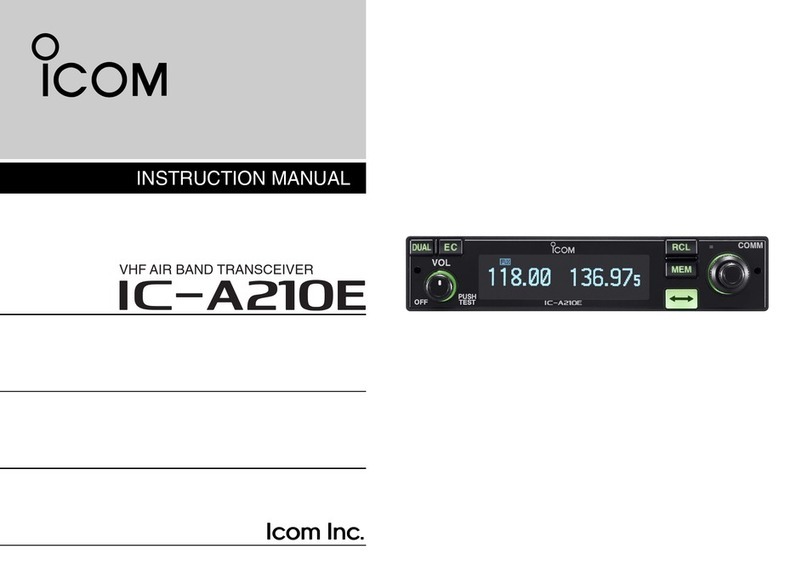
Icom
Icom IC-A210E User manual
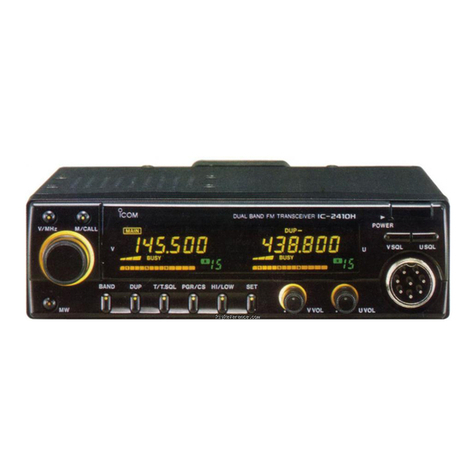
Icom
Icom IC-2410A User manual
